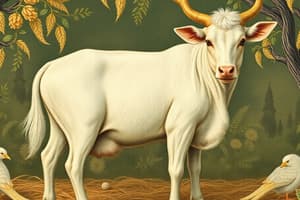Podcast
Questions and Answers
What are roughages?
What are roughages?
- Low fiber feeds
- Bulky feeds high in fiber, low in energy (correct)
- Animal protein sources
- Concentrated carbohydrates
Roughages are used mainly by what kind of animals?
Roughages are used mainly by what kind of animals?
Ruminant and nonruminant herbivorous animals
Nutrients in roughages are made available by what?
Nutrients in roughages are made available by what?
Microbial digestion
What are types of roughages for feed?
What are types of roughages for feed?
What are forages?
What are forages?
Forages are mostly what?
Forages are mostly what?
Major component of forages?
Major component of forages?
Cellulose is composed entirely of?
Cellulose is composed entirely of?
What is the only use of cellulose in human food?
What is the only use of cellulose in human food?
Roughages contain high amounts of what?
Roughages contain high amounts of what?
What estimates the cell wall content of a feedstuff?
What estimates the cell wall content of a feedstuff?
What are the materials in the cell wall?
What are the materials in the cell wall?
What are in the cell contents of forages?
What are in the cell contents of forages?
What provides the structural strength of cell wall?
What provides the structural strength of cell wall?
What are cellulose molecules in rodlike chains that form bundles of fibers?
What are cellulose molecules in rodlike chains that form bundles of fibers?
What is in the cell wall matrix?
What is in the cell wall matrix?
What is hemicellulose?
What is hemicellulose?
The carbs in hemicellulose?
The carbs in hemicellulose?
The sugars contained in xylans, mannans, galactans?
The sugars contained in xylans, mannans, galactans?
The matrix of cell wall forms what?
The matrix of cell wall forms what?
As cell growth decreases, what happens to matrix?
As cell growth decreases, what happens to matrix?
What is the process that happens as cell growth decreases?
What is the process that happens as cell growth decreases?
What does the nutritional value of forages depend on?
What does the nutritional value of forages depend on?
As lignin content increases, digestibility?
As lignin content increases, digestibility?
What are nutrients in forages?
What are nutrients in forages?
2 sources of nitrogen?
2 sources of nitrogen?
What is the major protein?
What is the major protein?
What is a high-quality protein?
What is a high-quality protein?
What are 3 NPNs?
What are 3 NPNs?
What are nonstructural carbohydrates?
What are nonstructural carbohydrates?
What are structural carbs?
What are structural carbs?
Which kind of carbs are readily fermented in the rumen?
Which kind of carbs are readily fermented in the rumen?
Are B vitamins high in roughages?
Are B vitamins high in roughages?
Where do herbivores get B vitamins from?
Where do herbivores get B vitamins from?
Green forages are a good source of what?
Green forages are a good source of what?
What are deleterious factors?
What are deleterious factors?
Is proximate analysis accurate for roughages?
Is proximate analysis accurate for roughages?
What is a better system for forage analysis?
What is a better system for forage analysis?
What is the Van Soest system?
What is the Van Soest system?
What is the detergent insoluble fraction?
What is the detergent insoluble fraction?
What are the 2 Van Soest procedures?
What are the 2 Van Soest procedures?
NDF does what?
NDF does what?
Flashcards are hidden until you start studying
Study Notes
Roughages Overview
- Roughages are bulky feeds characterized by high fiber content and low energy levels.
- Primarily consumed by herbivorous animals, both ruminant and nonruminant.
Nutritional Aspects
- Nutrients from roughages become accessible through microbial digestion.
- Major nutrient component of roughages includes plant cell walls, primarily cellulose.
Types of Roughages
- Common types include pasture, hay, dehydrated forage, silage, crop residues, and by-products such as straw and hulls.
Forages Definition
- Forages refer to plants specifically cultivated for animal feed, usually consisting of grasses or legumes.
Plant Cell Wall Composition
- Cell walls primarily consist of cellulose, hemicellulose, pectin, silica, and lignin.
- Cellulose molecules are structured into microfibrils, which provide strength and form fibrous bundles.
Importance of Cellulose and Lignin
- Cellulose and lignin are crucial for structural integrity of plant cell walls.
- Nutritional value of forages is influenced by the proportions of cell contents, wall constituents, and degree of lignification.
Digestibility and Nutrient Profiles
- Higher lignin content correlates with decreased digestibility in animals.
- Nutritional components in forages include nitrogen, carbohydrates, minerals, vitamins, and potentially harmful substances.
Nitrogen Sources
- Nitrogen mainly comes from proteins and non-protein nitrogen (NPN) sources like amino acids, nitrates, and ammonia.
- Chloroplast proteins are identified as the primary protein source in forages.
Carbohydrates in Forages
- Nonstructural carbohydrates, such as starches and simple sugars, are quickly fermented in the rumen.
- Structural carbohydrates constitute the cell wall components.
Vitamins in Forages
- Forages are rich in B vitamins, which are sourced from microbial fermentation during digestion.
- Green forages also provide Vitamin E and beta-carotene, the precursor to Vitamin A.
Deleterious Factors
- Roughages may contain harmful substances like alkaloids, glycosides, toxic amino acids, and mycotoxins.
Analytical Methods
- Proximate analysis is inadequate for characterizing roughages due to its inability to accurately separate carbohydrate fractions.
- The Van Soest system is preferred, involving the boiling of samples in detergent solution to isolate various components.
Van Soest System Procedures
- Key procedures include Neutral Detergent Fiber (NDF) and Acid Detergent Fiber (ADF), which help measure fibrous cell wall content and other fractions.
Summary
- Ensuring proper analysis and understanding of roughages is essential for optimizing animal nutrition and health.
Studying That Suits You
Use AI to generate personalized quizzes and flashcards to suit your learning preferences.




